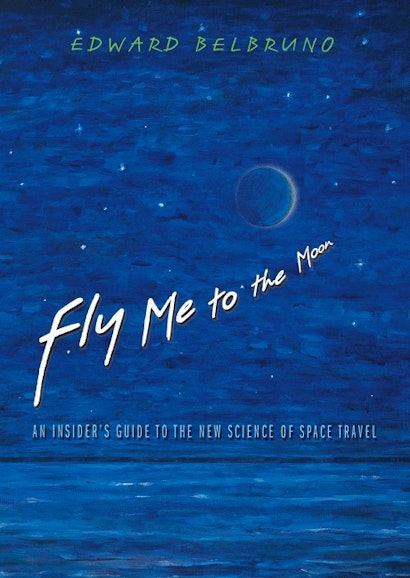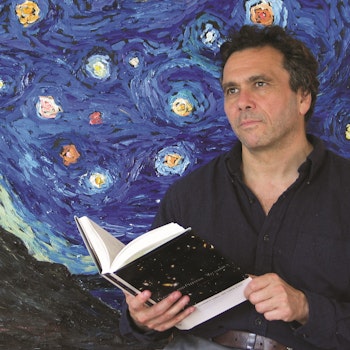When a leaf falls on a windy day, it drifts and tumbles, tossed every which way on the breeze. This is chaos in action. In Fly Me to the Moon, Edward Belbruno shows how to harness the same principle for low-fuel space travel—or, as he puts it, “surfing the gravitational field.”
Belbruno devised one of the most exciting concepts now being used in space flight, that of swinging through the cosmos on the subtle fluctuations of the planets’ gravitational pulls. His idea was met with skepticism until 1991, when he used it to get a stray Japanese satellite back on course to the Moon. The successful rescue represented the first application of chaos to space travel and ushered in an emerging new field.
Part memoir, part scientific adventure story, Fly Me to the Moon gives a gripping insider’s account of that mission and of Belbruno’s personal struggles with the science establishment. Along the way, Belbruno introduces readers to recent breathtaking advances in American space exploration. He discusses ways to capture and redirect asteroids; presents new research on the origin of the Moon; weighs in on discoveries like 2003 UB313 (now named Eris), a dwarf planet detected in the far outer reaches of our solar system—and much more.
Grounded in Belbruno’s own rigorous theoretical research but written for a general audience, Fly Me to the Moon is for anybody who has ever felt moved by the spirit of discovery.
"[This book] will truly excite anyone interested in the future of space travel. . . . Grounded in real physics, Belbruno's ideas will tantalize the space audience."—Gilbert Taylor, Booklist
"A small group of scientists has worked on new orbits that take into account the inherently chaotic motion of object in a multibody system. . . . One of the innovators in what is known as 'capture dynamics', Ed Belbruno, provides a basic and eminently readable introduction to the topic in Fly Me to the Moon."—Jeff Foust, The Space Review
"This book does for mathematics what The Double Helix did for biochemistry, without the gossip and diatribe that made The Double Helix so controversial...Overall, this book is a superb introduction to the life of a real mathematician, and a gentle introduction to some very complex mathematics."—Jeff Suzuki, MAA Review
"Fly Me to the Moon provides a fast, very readable account of new developments in chaotic celestial mechanics, especially low-fuel space travel, at a level appropriate for a general audience. By the end, nonmathematicians will have gained some intuition about one of the hallmarks of chaos, sensitive dependence on initial conditions, and how chaos can be harnessed to good purpose. All readers will walk away thinking differently about the cosmos. Far from being a clockwork, it will seem more dynamic, more turbulent, and full of diverse possibilities."—Shane Ross, Notices of the American Mathematical Society
"Belbruno beautifully describes his novel low-fuel concept in Fly Me to the Moon, using copious sketches to explain his theory without resorting to a single equation. . . . The author has laid out the book very well—a teaser of an introduction with just enough details of the Hiten rescue to whet the appetite, but leaving you hungry for more. The language is friendly yet enticing, with nice snappy chapter lengths and informative illustrations in just the right places. There is a good story line running through the book with little surprises like the author being granted a patent for his special route to the Moon in 2003, with many more patents to follow for routes to other destinations."—Gerard McMahon, Astronomy and Space
"[A] wonderfully informative book. . . . For anyone with an interest in this remarkable development in spaceflight the book is a must."—Colin Keay, Australian Physics
"Almost fifty years after the beginning of space flight, Belbruno's work offers a realistic beginning for minimum—fuel and maximum—payload trajectories for interplanetary operations. It is a mark of sophistication in the evolution of space travel that simplified solutions to the vexing many-body problem are found to have practical applications. Belbruno's three-body solution for low-thrust minimum-fuel trajectories serves well not only the future of space flight but helps astronomy in understanding the sometimes erratic motions of celestial bodies."—Edgar D. Mitchell, Apollo 14 astronaut
"Fly Me to the Moon is a fast, easy read that explains in simple nonscientific terms very complex matters of celestial mechanics, and it is delightful reading for students and professionals to update or learn very important new background materials. It is also a must-read for the lawyer-scientist."—Ambassador Edward R. Finch, Jr.
"This is an excellent book. The author succeeds in writing an exciting story about his research on low-fuel space travel, a subject that is not widely known but that will interest many readers. Moreover, the mathematical aspects of chaos in the context of space missions is well treated at the level of the nonexpert."—Florin Diacu, University of Victoria
"This is a good story. It is rare to see a nonpedantic book on celestial mechanics that gives some backroom stories about trajectory geeks. Belbruno ties very abstract concepts to real problems and situations."—Wendell W. Mendell, NASA Johnson Space Center, Astromaterials Research & Exploration Science Directorate
"This is an excellent book. It is an inside look at the important new field of chaotic trajectories by one of the masters and originators of the field. As we continue into space, I think we will be hearing more and more about these clever trajectories. Ed Belbruno has covered in a beautiful and interesting way the important applications of chaos to astrophysics and spacecraft trajectories. He also tells a very interesting personal story of his battles to get these trajectories used, and how he was able to save the Hiten spacecraft and get it to the moon. This is a great story, and he tells it very well."—Richard Gott, Princeton University
"The author's newly discovered interplanetary highways offer a romantic reflection of the pre-rocket, pre-airplane era, where balloons would transport us, with hardly any energy of our own, from one unexplored vista to another."—From the foreword by Neil deGrasse Tyson, astrophysicist and Director of the Hayden Planetarium, American Museum of Natural History, author of Death by Black Hole: And Other Cosmic Quandaries


